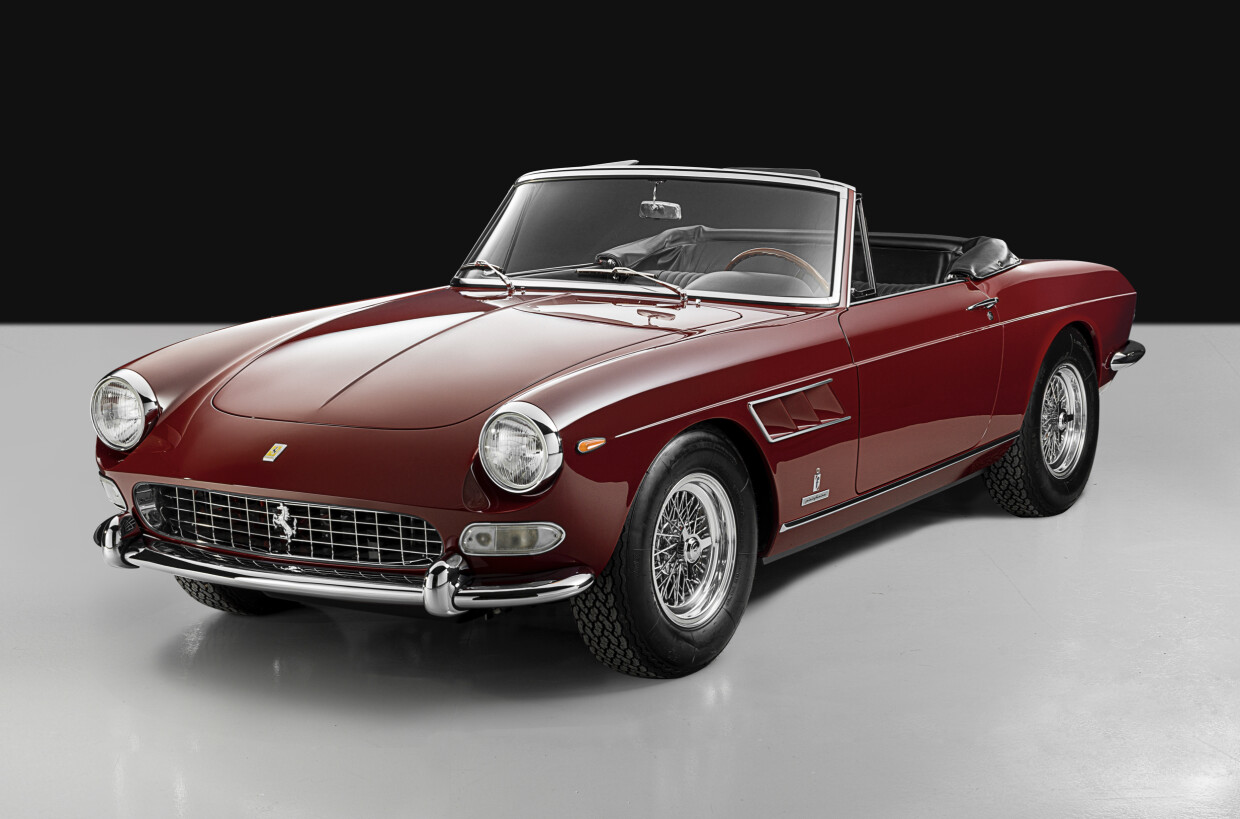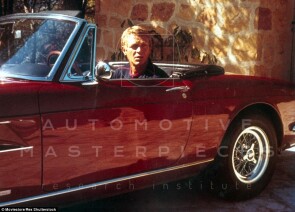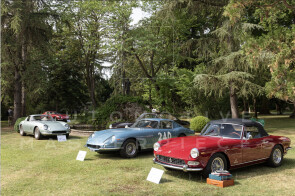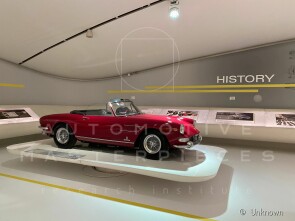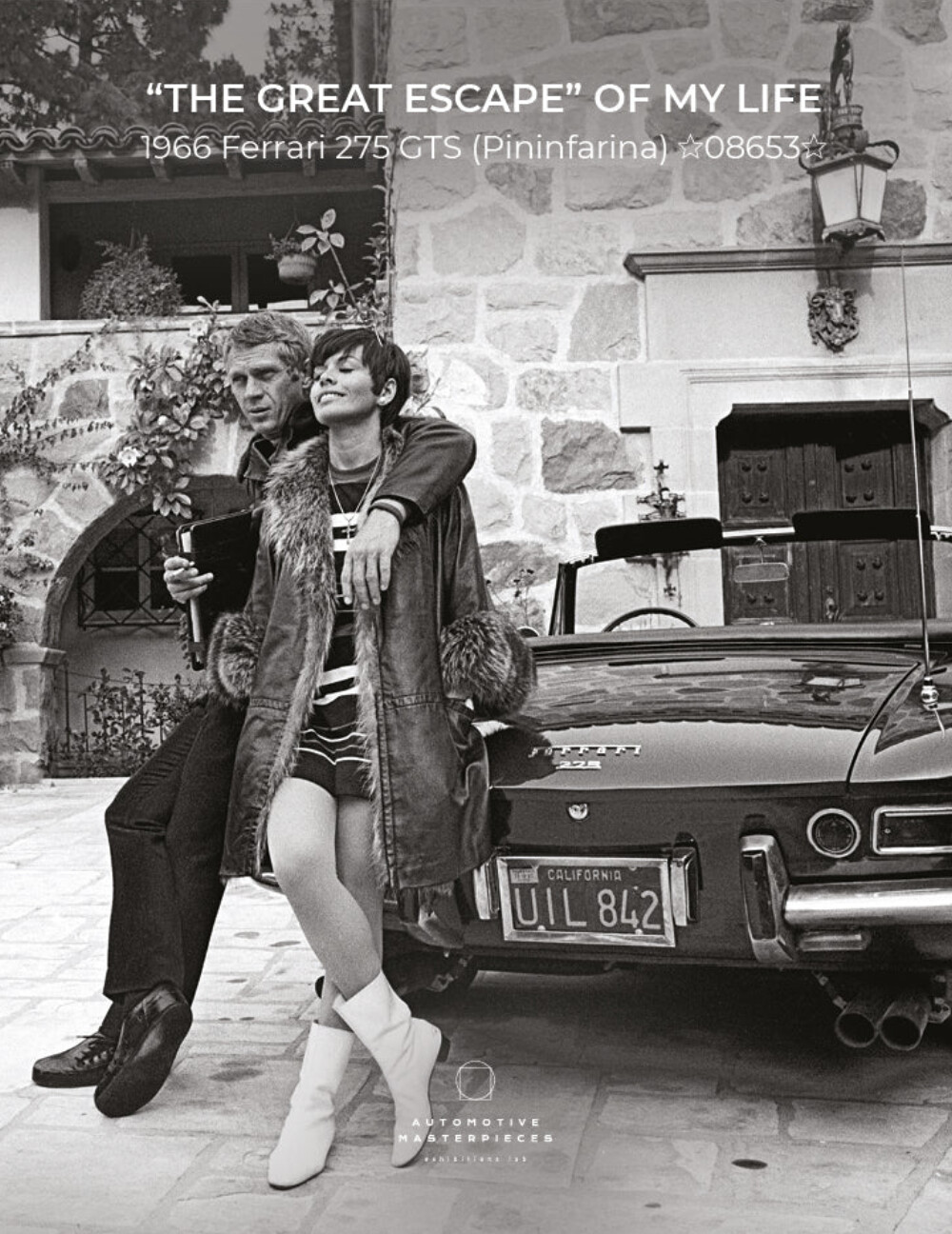
1966 Ferrari 275 GTS
ON/OFF
Why am I an Automotive Masterpiece?
K. Famous chassis’ cars
Last of 200 cars built.
L. Limited edition cars
no. 200 manufactured, 200th built
The Ferrari 275 GTB and GTS are respectively a berlinetta and a spider, both presented for the first time at the 1964 Paris Motor Show; both are the work of Pininfarina. The 275 GTS differs from the berlinetta for its slightly more classic and conventional body design, with more balanced and less aggressive proportions; among other small differences, it does not have faired headlights. The 275 GTS (as Gran Turismo Spider) was born as heir to the spider built on Ferrari 250s chassis and forcefully reaffirmed the front position of its 12-cylinder engine, as evidenced by its imposing front end; compared to the 250 chassis spider, however, it featured some innovative technical developments. The 275 GTS adopted, for the first time on a Ferrari grand touring car, 4-wheel independent suspension and a 5-speed gearbox. These important technical improvements were, in part, in response to the new Lamborghini which had introduced them to the production GTs with the 350 GTV. The line of the 275 GTS was supported by an oval-section tubular steel spar frame with diagonal tubular extensions. A long hood emphasizing its V12 engine. While the GTB berlinettas were assembled by the Scaglietti body shop in Modena, the GTS were set up directly in Turin by Pininfarina itself. The 275 GTS, compared to, the 275 GTB appeared simpler and more classic, without the fairings on the headlights, with a lower inclination of the windshield and with a taut and clean line, underlined by a slight molding that ran along the entire side and was re-proposed both on the bonnet and on the trunk. Later, side vents were added similar to those already present on the 250 GTE, but in due course they were replaced by reed air intakes. The 275 GTS interior was leather with a full dashboard (speedometer, tachometer, oil temperature, oil pressure, fuel gauge, analog clock, water temperature and ammeter), wooden steering wheel, aluminum gear selector grille, ashtray and aluminum door sills. The position of the handbrake lever is curious being located on the side in front of the gear lever. At the mechanical level, while with the Ferrari Formula 1 single-seaters and the Sports cars of the mid-1960s showed themselves to be at the forefront, but substantially in line, with what other important European manufacturers were proposing, in the GT sector they took a more conservative approach, jealous and proud, unwilling to break away from the traditional layout of the 12-cylinder engine, placed in the front position. The alloy V12 designed by Gioachino Colombo was maintained with an increased bore to reach the unit displacement of 275 cm³ and total displacement of around 3.3 liters. It was powered by 3 double-barrel Weber carburetors (which allowed 280 hp at 7600 rpm) or 6 double -barrel Weber carburettors (with power reaching 300 hp at 7500 rpm). The power of the spider GTS was a slightly more restrained 260 hp. The 275 is both the last Ferrari with single camshaft distribution and the first with double camshaft, when the 1966 GTB/4 version was introduced; a (very) small number of the latter were offered in the N.A.R.T. spider version. The 275 GTS chassis was made of a special 596 steel tube trellis. The suspension was independent for all four-wheels, with deformable wishbones on all wheels and anti-roll bars front and rear. The brakes were Dunlop 4-wheel disc brakes with brake booster. The biggest innovation was a completely redesigned 5-speed gearbox built entirely by Ferrari, placed above the rear axle, in block with the differential, according to the Transaxle scheme. The steering was screw and roller. The 275 GTS was dressed with innovative light alloy wheels, although it could also mount 15” Borrani wire wheels. All this made the car both very manageable and fast, however its performance was penalized by its weight and small disc brakes, not very resistant to fading. The most important mechanical modification was the adoption of a tube that solidly joined the engine and gearbox through which the drive shaft passed, this increased the torsional rigidity and reduced vibration, greatly increasing ride comfort. A total of only 200 Ferrari 275 GTS were built.
Car chassis no. 08653 was the last Ferrari 275 GTS to be produced, model number 200, finished in black (Nero 18656 S Italver) with Franzi (NR2) black leather interior and fitted with black carpets; the only car with this “triple” black finish. It was fitted with Borrani wire wheels and a special gearbox in cast iron (instead of the usual aluminum). Being one of the only 73 US-export model built, it was equipped with a speedometer in miles, full red (and not red-amber) taillights and an additional Bendix pump. Other rare, if not indeed unique, details include the sports mirror, antenna, radio and central audio speaker. The car had been specifically requested by the famous Hollywood movie star and racing driver Steve McQueen. Construction of the car was completed on May 30, 1966. It is assumed that, in reality, originally the plan for the 275 GTS foresaw building only 199 cars. The car was then sent for the US import and then finally delivered by the importer Chinetti to Mr. Bill Harrah, owner of Modern Classic Car, who was a long time Ferrari dealer and friend of the actor. This Ferrari was Steve McQueen's car at the height of his career, when his fame was consolidated by international success. The Ferrari 275 GTS with chassis no. 08653 was the second Ferrari owned by McQueen, after a 250 GTL and was subsequently followed by a pair of 275 GTB/4s: a short lived spider N.A.R.T. and a berlinetta. The "all black" finish was initially expressly requested only, after seeing the car, for him to reconsider before actually taking possession of the car, it was therefore repainted in Rosso Amaranto 20-R-187. McQueen was known for his habit of lightly customizing his carsand entrusted the car to Lee Brown, the owner of Precision Auto Body in Hollywood during the 1960s, who famously customized the “Highland Green” Ford Mustang co-starring in the “Bullitt” movie. The Ferrari 275 GTS with chassis no. 08653 was registered on black California license plates “UlL 842”. The car, with McQueen at the wheel, was present at the Opening Night event at the Coconut Grove Ambassador Hotel in Los Angeles in October 1966. In a photo shoot from early 1967 the car can also be seen in the images in the main courtyard of the McQueen mansion in Brentwood (West Los Angeles), it was the only car chosen from the McQueen’s extensive personal collection which included (among others) such iconic vehicles as a Jaguar XKSS, a Mustang and a Corvette. McQueen and his wife Neile Adams are portrayed leaning against the Ferrari. As its replacement, a 275 GTB4 was soon ordered and delivered to McQueen in November 1967, the car's life with the actor, as intense as it had been, quickly drew to a close. On January 14, 1968, the first announcement of the car for sale appears in Hollywood Sport Cars; McQueen’s name is not mentioned indicating only the low mileage and the plate number. The history of the car sees some ownership changes. In 1994 it was subject to fire damage, being among those cars affected in the fire that destroyed the collection of David Scaife, Exotic Cars of Pittsburgh, Pittsburgh, PA. The car, however, was parked some distance from the outbreak and was only slightly damaged and could be fully repaired without problems. In may 2001 chassis no. 08653 was bought by Tom Meade and registered with a new title. Meade stored parts of the 275 GTS under restoration together with three other Ferrari chassis’s at a nearby building that changed property. The four cars disappeared. The problem stems from the fact that Tom had spent a long period in hospital in a very serious condition; hence, he was unavailable at the time of the change of ownership of the residential complex, in which he had a garage storage for his cars. Solved the problem, the car was then partially disassembled for maintenance and shipped to Italy where it has remained ever since. The car, almost forgotten for many years and "rediscovered", became the property of another great Ferrari collector. Finding the car with a partial restoration underway the activities were stopped and a full restoration was started in May 2018. After the purchase of the car, six months was dedicated to planning its restoration. The inspection of the car revealed the presence of all its original "numbers", including the body number 200, present on the front, which is still clearly visible. Brought to bare metal, the original black color was found underneath the red paint. It was decided to repeat the original sequence, first repainting the car again in the same Nero 18.656 S. Italver, which McQueen had ordered and which it bore when it left the Ferrari factory in May 1966, and then to proceed to “restore” it to its “new” red paint, Rosso color palette Amaranto 20-R-187, on top of the black. In this way, the car today is exactly as it was when Steve McQueen drove it, with two perfect layers of paint. The mechanical components have been meticulously restored to their former glory. Nothing has been left to chance. Restoration ended in January 2021 and, in February 2021, Ferrari Classiche issued its “certificate of authenticity” indicating a car of exceptional “authenticity”.
